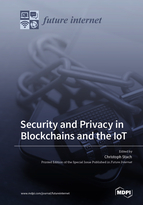Security and Privacy in Blockchains and the IoT
A special issue of Future Internet (ISSN 1999-5903). This special issue belongs to the section "Internet of Things".
Deadline for manuscript submissions: closed (27 April 2022) | Viewed by 30953
Special Issue Editor
Interests: trustworthy data science and analytics; security techniques for the Internet of Things; secure data management; privacy-aware smart services; privacy-aware big data processing; privacy-aware machine learning
Special Issues, Collections and Topics in MDPI journals
Special Issue Information
Dear Colleagues,
The Internet of Things (IoT) is leaving its mark on an ever-increasing number of domains. Sensors embedded in everyday objects (e.g., smart watches) enable the continuous capture of a large amount of data. Since such IoT devices feature connectivity to other IoT devices and cloud services, the captured data can be shared for processing and analyzing. Blockchain technologies are often applied to ensure immutability and temperature resistance of the shared data. Actuators are able to react automatically to patterns found in these data. This enables a variety of innovative smart services, e.g., in the eHealth or Industry 4.0 domain.
However, the data required for smart services are highly sensitive. For instance, health data contain a lot of private information, while industrial data have a high economic value. Therefore, novel privacy and security mechanisms are required that are tailored to the IoT and blockchain technologies. When designing such mechanisms, it is important to consider applicable data protection laws, such as the EU General Data Protection Regulation (GRPR).
The goal of this Special Issue is to provide an overview of the latest developments regarding security and privacy in blockchains and the IoT. Both theoretical and technical aspects are of interest. Interdisciplinary approaches are also highly welcome.
Topics of interest include but are not limited to the following:
- Lightweight and privacy-preserving authentication in the IoT;
- Mechanisms to ensure confidentiality and data integrity during transmission, processing, and storage;
- Secure data management architectures for big data;
- Novel data and index structures for resource-efficient blockchains;
- Privacy-aware and utility-preserving data processing and machine learning techniques;
- Demand-oriented data provisioning and distribution under consideration of privacy requirements;
- Fine-grained access control for dynamic IoT environments;
- Trust-building approaches regarding the genuineness and validity of IoT data;
- Security, privacy, and legal assessment of IoT systems and applications;
- Experience reports on privacy and security threats to the IoT as well as approaches to prevent such threats.
Dr. Christoph Stach
Guest Editor
Manuscript Submission Information
Manuscripts should be submitted online at www.mdpi.com by registering and logging in to this website. Once you are registered, click here to go to the submission form. Manuscripts can be submitted until the deadline. All submissions that pass pre-check are peer-reviewed. Accepted papers will be published continuously in the journal (as soon as accepted) and will be listed together on the special issue website. Research articles, review articles as well as short communications are invited. For planned papers, a title and short abstract (about 100 words) can be sent to the Editorial Office for announcement on this website.
Submitted manuscripts should not have been published previously, nor be under consideration for publication elsewhere (except conference proceedings papers). All manuscripts are thoroughly refereed through a single-blind peer-review process. A guide for authors and other relevant information for submission of manuscripts is available on the Instructions for Authors page. Future Internet is an international peer-reviewed open access monthly journal published by MDPI.
Please visit the Instructions for Authors page before submitting a manuscript. The Article Processing Charge (APC) for publication in this open access journal is 1600 CHF (Swiss Francs). Submitted papers should be well formatted and use good English. Authors may use MDPI's English editing service prior to publication or during author revisions.
Keywords
- Confidentiality
- Integrity
- Authenticity
- Access control
- Security
- Privacy
- Efficient blockchain technologies
- Trustworthy smart services
- Privacy-aware machine learning
- Data protection laws in the context of blockchains and the IoT
Related Special Issues
- Security and Privacy in Blockchains and the IoT II in Future Internet (18 articles)
- Security and Privacy in Blockchains and the IoT III in Future Internet (2 articles)






